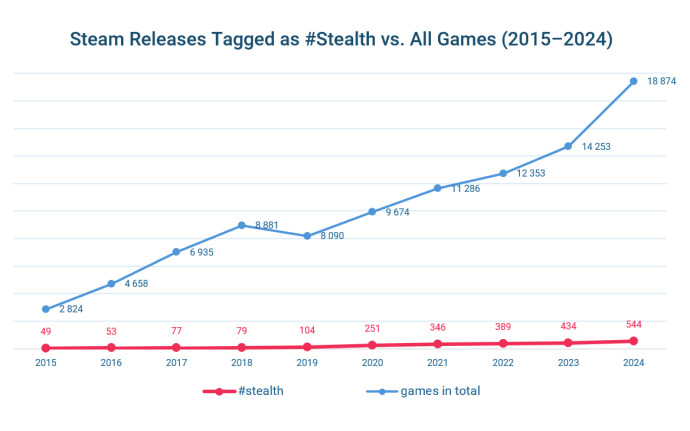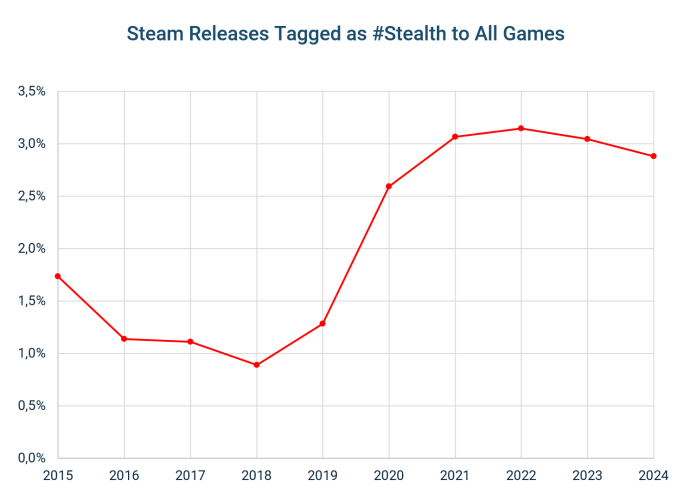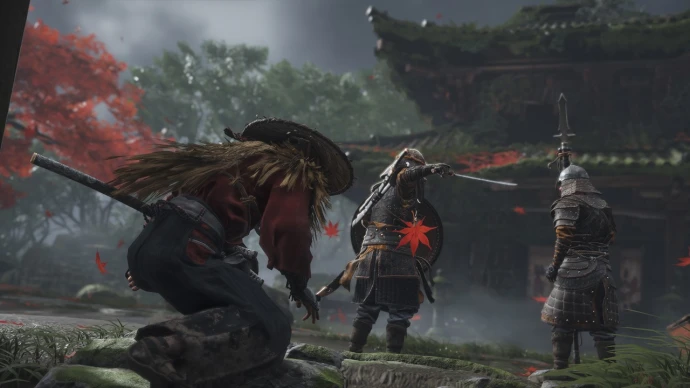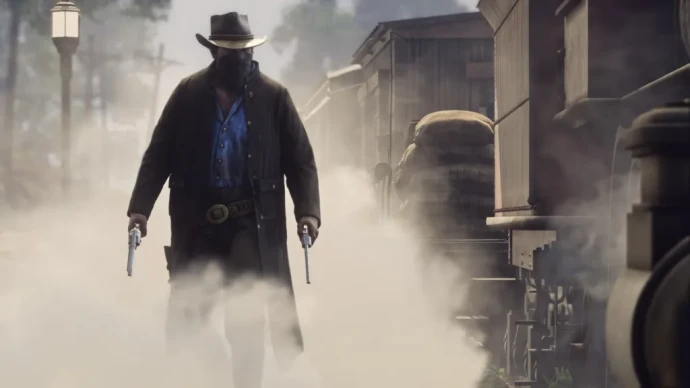The Psychology of Stealth Players: Trends, Behavior, and Motivation of Silent Operators
- May 12, 2025
- Michał Dębek
- Is Stealth Still a Niche? The Data Says: Yes — and No
- From Tag to Mechanic: How Stealth Became Part of Mainstream Design
- Why Pure Stealth Games Rarely Scale — Even When They Succeed Creatively
- Flexible Systems, Not Fail States: How Modern Stealth Encourages Improvisation
- Blending Genres: RPG Progression, Crafting, and Tactical Layering
- Who Plays Stealth Games — and What Motivates Them
By the end of 2024, Steam had listed 4,379 titles tagged as #stealth. That’s not a staggering number, considering the overall volume of releases on the platform — but it’s enough to form a distinctive niche with a surprising degree of internal diversity.
Within that group, we find the genre’s heavy hitters — Hitman, Dishonored, Metal Gear Solid — all of which have helped define what stealth gaming means today. They offer systemic level design, AI-driven responsiveness, and a tactical mindset that rewards patience over aggression.
Alongside these classics, however, sit smaller and more experimental titles — some of them critically acclaimed despite (or perhaps because of) their niche appeal. Gloomwood, for instance, revives the spirit of Thief with unapologetically old-school stealth design, while Stray uses stealth more sparingly, folding it into a broader experience centered on rhythm, vulnerability, and environmental storytelling.

The share of games tagged as #stealth remains marginal — in recent years, it has hovered around just 3% of all PC releases on Steam. Between 2015 and 2018, stealth titles made up only a tiny fraction of the overall output. But starting in 2019, we’ve observed a clear uptick: from just 1.3% in that year to nearly 3% by 2024. That may not sound impressive at first glance, but it represents a dramatic rise from just five years earlier. That said, the growth rate for Stealth titles on Steam has recently slowed down.
Is Stealth Still a Niche? The Data Says: Yes — and No
That may not sound impressive at first glance, but it represents a dramatic rise from just five years earlier. That said, the growth rate for Stealth titles on Steam has recently slowed down. The Stealth tag has also been assigned to a fair number of Steam’s top sellers, representing other genres, with Stealth being a complementary mechanic.
Between 2021 and 2024, the number of new #stealth games on Steam grew by roughly 57%, while the total number of new PC releases rose by around 67%.
In other words, stealth is expanding, but slightly below the market average.

To sum up: #stealth, not necessarily as a standalone genre but increasingly as a meta-mechanic, now plays a larger role in the PC games landscape than it did a decade ago — even if it remains a micro-niche in quantitative terms. In terms of market penetration, #stealth is negligible compared to dominant tags like FPS, battle royale, or MOBA in terms of the number of games.
From Tag to Mechanic: How Stealth Became Part of Mainstream Design
But there’s an interesting paradox here: while pure stealth games rarely make it onto the best-selling charts and continue to claim only a minimal share of the market, stealth mechanics have become nearly ubiquitous across AAA blockbusters. Just look at Ghost of Tsushima, Tom Clancy’s Ghost Recon, The Last of Us, or the brilliantly executed netrunner-hacker build path in Cyberpunk 2077.
Stealth has evolved into an optional playstyle embedded within mainstream design — part of a broader trend toward genre-mechanical diffusion. Even action-forward series like Horizon or Uncharted routinely integrate stealth as a fluid gameplay layer.

The same applies to titles not typically associated with stealth at all — Red Dead Redemption 2 or Far Cry 6 — where silent takedowns, enemy detection cones, and basic noise management quietly coexist with systems built for open confrontation. These mechanics may not define the game, but they’re there — acknowledged, supported, and often embraced by the player base as legitimate tactical options.
Together, these titles illustrate a simple truth: stealth today is no longer a single concept — it’s a design language that can be central, peripheral, or purely atmospheric, depending on how the developer chooses to utilize it.

Why Pure Stealth Games Rarely Scale — Even When They Succeed Creatively
Meanwhile, orthodox stealth increasingly feels like a domain for connoisseurs. Yes, there are occasional standouts — Assassin’s Creed Mirage / Shadows, Dishonored, Sniper: Ghost Warrior, or legacy giants like Metal Gear and Hitman, which have remained genre-defining icons for over two decades. But these only sporadically break into mainstream awareness or reach multi-million sales.
Most simply don’t. As with many niche genres, solid reviews and high production values are no guarantee of commercial viability. A striking example is Mimimi’s real-time-tactic games with stealth — Desperados III and Shadow Gambit: The Cursed Crew.
Both earned the “Mighty” badge on OpenCritic and are beloved by fans, but neither achieved the level of sales required to sustain the studio, which has since closed its doors despite its strong creative track record.
There are likely many more stories like this because numerous stealth-focused games, especially those designed as strictly stealth-first experiences, appear to be operating on the thin edge of profitability.
Publicly available data suggests that even well-reviewed stealth titles, appreciated by both fans and critics, rarely cross the threshold of several hundred thousand copies sold. Based on estimates from SteamSpy and similar aggregators, games like Aragami 2 and Gloomwood are believed to fall somewhere between 200,000 and 500,000 units.
Granted, Gloomwood has been in Early Access for over three years — but even so, numbers like these, achieved over a relatively long and carefully managed production cycle, are often not enough to let a studio breathe financially without external support.
Flexible Systems, Not Fail States: How Modern Stealth Encourages Improvisation
Modern stealth design prioritizes flexibility over punishment. Developers are increasingly reluctant to frustrate players by enforcing a strictly silent playstyle. Even games traditionally rooted in stealth — like Hitman: World of Assassination or Dishonored 2 — now encourage creativity over orthodoxy. They forgive more, not less.
In titles like Sniper Elite 5 or Metal Gear Solid V: The Phantom Pain, the stealth experience often unfolds as an emergent narrative, built not from scripted sequences but from the dynamic interaction of systems. Level design follows suit: missions become dense stealth sandboxes, where multiple approaches coexist even within so-called “ghost runs.” No two silent playthroughs are quite the same — and that’s by design.
It’s also telling that even games branded as “pure stealth” — Gloomwood, Aragami 2, or Shadow Tactics: Blades of the Shogun Aiko’s Choice — tend to allow non-stealth solutions, if only to give players room to adapt when a plan goes south. With this shift comes an inherent non-linearity that extends replayability, prolongs a game’s commercial lifespan, and, perhaps most importantly, boosts its social footprint — encouraging speedruns, pacifist challenges, and shared experimentation across YouTube, Twitch, and Discord.
Blending Genres: RPG Progression, Crafting, and Tactical Layering
Another clear trend is the integration of stealth mechanics with RPG-style progression systems and crafting. As a result, already complex stealth toolsets become even more diversified, giving players broader tactical agency and room for personalization.
The stealth niche is rapidly evolving, and its future, in my view, lies in hybridization: a synthesis of traditional, increasingly refined, and simulation-driven stealth systems with mechanics borrowed from adjacent subgenres, such as RPGs, immersive sims, or survival games.
This diffusion goes both ways. Just as stealth elements now appear in action-adventure games — often as secondary or optional layers — stealth-focused titles are adopting mechanics once foreign to the genre: character progression trees, loot loops, exploration-driven level structures, and modular buildcrafting.

Styx: Shards of Darkness, for example, blends stealth assassination with a skill tree and co-op RPG-style progression. Chernobylite — a survival-horror game with a strong emphasis on stealth — combines its infiltration gameplay with base management and nonlinear crafting. Meanwhile, The Pathless subtly integrates stealth traversal into a movement-centric action game, proving that stealth systems can even coexist with rhythm and momentum as core design pillars. These cross-pollinations not only reshape stealth’s boundaries but also help the genre stay culturally and commercially relevant.
Because stealth has adapted by absorbing the strengths of other genres — especially RPGs and immersive sims — making it more versatile, personal, and viable in today’s design and market landscape.
Who Plays Stealth Games — and What Motivates Them
But what does today’s stealth-inclined player actually look like? That’s exactly what we set out to investigate — and what you’ll find in our report, including a free sample available below.
Publicly available data suggests that stealth enthusiasts spend more time with their favorite games than the average player — likely because stealth demands patience, planning, and a mindset geared toward systemic experimentation. Our own research based on Psychogenic Equilibrium Theory of Gamer Motivation confirms this: stealth players often expect flexibility — the ability to approach objectives in various ways, rather than following a single path.
Many adopt a hybrid style, starting in stealth and switching to open combat when things go sideways. I count myself among them — though I also enjoy going the other way: pushing stealth systems to their limits, refining my approach until I can ghost an entire mission, clean and silent.
This report includes findings from French players across age groups, as well as Gen Z stealth fans from other countries. Together, they form a detailed composite of the modern stealth player — and a starting point for further exploration.
If you’re curious about the world of players who take pride in silent movement, unnoticed takedowns, meticulous environmental scanning, and decoding spatial puzzles — sign up below and get your free sample report.
From the sample, you’ll learn:
- Who plays stealth games in France
- What their demographics and gaming behaviors look like
- Which sub-genres correlate with stealth preferences
- Key motivations and frustrations of stealth enthusiasts
- Cross-regional motivational drives (France vs. South Korea)
- Top preferences and aversions among stealth game fans
- How stealth players differ from other gamer segments
- How they discover new games — and what makes them buy
- Which franchises dominate their top-of-mind awareness






